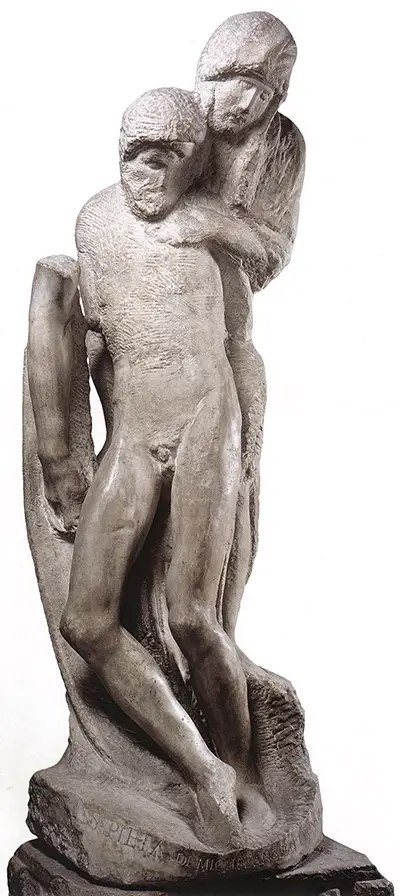Carved from a single block of marble, the sculpture depicting the Virgin Mary grieving over the body of Christ stands to a height of 74 inches.
Begun in 1552 then abandoned in 1553 Michelangelo would return to the Rondini Pieta in 1555 and although he would never complete the work, he continued to work on it until his death. Elements of the original design can be seen in Christ's right arm which is no longer attached to his body and in Christ's legs. The rest of the sculpture would continue to evolve throughout the artist's lifetime.
A pieta is a reflection on the theme of the Virgin Mary mourning over the body of Christ, usually a sculpture, and Michelangelo worked on several throughout his career. The Rondanini Pieta stands in sharp contrast to his early works which featured idealised, robust, Renaissance style representations of Christ and the Virgin Mary.
Working on the Rondanini Pieta in the final stages of his life, Michelangelo's sense of his own mortality is conveyed in the frail, thin, elongated representations of Christ and Mary. As he worked on the sculpture, Michelangelo made changes which brought the two figures closer together.
He changed the direction of Mary's face and altered Christ's position so that he almost seems to emerge from Mary and the two figures appear almost as one, emphasising the bond between mother and son. In fact, Michelangelo continued to carve Christ's body until he was working on the stone which originally depicted the Virgin Mary. In this way, Christ is literally carved out of her body.
As Michelangelo lost his own mother at just six years of age, this theme of the close bond between mother and son would be a deeply personal one for the artist. The relationship between Mary, the mother, and Christ, her son, takes on additional depth in the different angles of the sculpture. Viewed from the side, the figure of Christ seems to support the Virgin Mary upon his back, as though she is draped upon him and he is supporting her through her grieving. Viewed from the rear, the two figures seem to merge into one.
Michelangelo worked on several pietas towards the end of his life as he seemed to become more pre-occupied with his own mortality and spirituality. The Rondanini Pieta is unique in its style which is more typical of gothic or even modern abstract representations.
Perhaps for these reasons, and the fact that the sculpture was unfinished, it changed hands many times and was largely ignored for centuries until the city of Milan purchased and displayed the piece in the 1950's. Michelangelo's last sculpture is now displayed in the Museum of Rondanini Pietà of Sforza Castle in Milan, a museum dedicated exclusively to this unique work of art.
Despite being lauded as a painter, particularly for his frescos on the ceiling of the Sistine Chapel, Michelangelo considered himself first and foremost a sculptor. Due to his mother's illness and subsequent death when Michelangelo was still a young child, he was sent to live with a family of stonecutters.
These early years spent in the company of the stonecutters had such a great influence on Michelangelo that he would later report of the experience, “I sucked in chisels and hammers with my nurse’s milk.”
It was here too that he would develop his love of stone and of marble in particular. As a sculptor, Michelangelo was incredibly particular about the marble he worked from and would make numerous trips to the renowned marble quarries in the town of Carrera to select the best stone for his sculptures. Such was his admiration for the material that he is quoted as saying "Every block of stone has a statue inside it and it is the task of the sculptor to discover it."
As well as being influenced as a sculptor by his experience of living with the family of stonecutters, Michelangelo would be shaped by his studies at the school of Lorenzo de' Medici under the famous sculptor Bertoldo di Giovanni, who was himself a student of Donatello.
It was while still only in his twenties that Michelangelo, already regarded as one of the best artists of his time, created one of the greatest and most iconic masterpieces in all of art, his statue of David. The immediate success of the sculpture established Michelangelo as the greatest sculptor of the Renaissance period, arguably, the greatest sculptor of all time.


